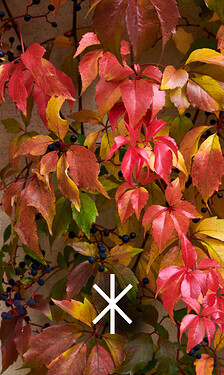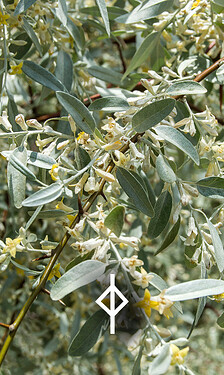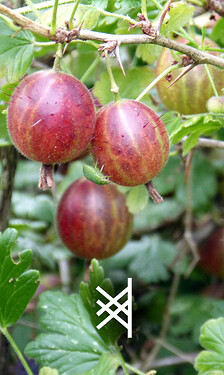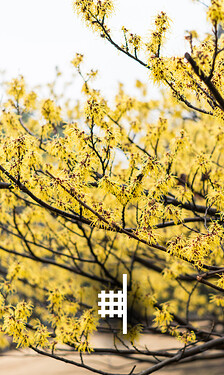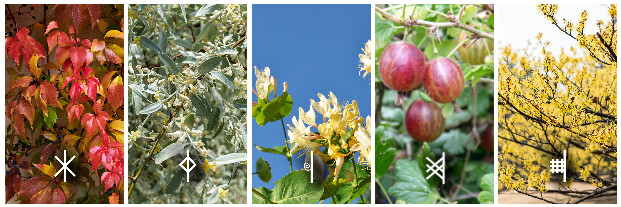We have finished all four of the aicme in the ogham, and now it is time to cover the forfeda. These fíd are not always included in ogham divination, and it is up to the diviner whether they use them or not. I will talk more about the forfeda below.
First, if you need a refresher…
Ogham is an ancient Irish inscription alphabet that was used to inscribe headstones and other important markers. In mythology, it was created by the God Ogma (OH-muh) to warn Lugh about a plot to steal his wife. Today, Ogham is used in magic and divination.
If you want to learn more about what ogham is in general, I wrote about that here: Irish Tree Language - The Ogham ![]()
I also have a video explaining the origin story of ogham that you can watch here: https://youtu.be/CWEm2pcAFc8
The forfeda of the Ogham scales in the Book of Ballymote
Public Domain, File:Forfeda.png - Wikimedia Commons
What is the Forfeda?
The forfeda is the name for the group of ogham feda that were individually added to the ogham at a much later date. The names of these feda are Ebad, Ór, Uillend, Pín, and Emancholl. Their meanings also vary widely, with different Neo-Pagan sources having different associations with each fíd. Scholars are also on the fence about their meanings. Erynn Rowan Laurie, in her book Weaving Word Wisdom, says that she believes even medieval ogham users didn’t agree on their use because they are included in some manuscripts and left out of others.
The forfeda consist of five feda (letters) that don’t follow the same creation format as the first four aicme. What I mean by this is that they are not just a single line with slashes. Some of them cross, one has a swirl, and another looks like a number sign.
My temporary physical ogham cards. From left to right, the forfeda are Ebad, Ór, Uillend, Pín, and Emancholl.
Rather than cover each foreda in an individual post, I have decided to cover them all in one. This is because, unlike their counterpart feda, the forfeda have very little known information. Most of what is known about them has been gathered from other sources or inferred based on a person’s personal gnosis.
The information I present about the forfeda comes from my personal experience with them, as well as many available sources. I have included links at the bottom of this post if you are interested in further reading.
Table of Contents
For easier navigation in this post, I have included links here to each of the letters below. Click on the letter you want, and it will take you directly to that letter’s information.
– Ebad
– Ór
– Uillend
– Pín
– Emancholl
Ebad - Woodbine
Ebad is the first forfeda, and it almost looks like an asterisk. The translation of this word, as written in Weaving Word Wisdom, is given as Salmon. It is associated with several trees, including elecampane, woodbine, and aspen.
There are several word oghams associated with Ebad.
- snámchaín feda - fair-swimming letter, best swimming letter
- cosc lobair - admonishing of an inferm person, correction of a sick man, desire of an invalid, feast of an invalid
- caínem éco - fairest of fish, most lovely of salmon
If we look at The Ogham Tract, we can see evidence of this fíd and the word oghams.
Snamchain feda, most buoyant of wood, that is ebad, aspen, with him, for fair swimming is wood; that is a name for the great raven. Hence it was put for the letter named the Ogham ebad, for e is a name for salmon, and it is written by ea like the alphabet of the fauna: i.e., by stag (deer), eo by eonasc (ousel).
I think this fíd requires some cultural context. After all, it is the only fíd that translates to an animal. In Irish mythology, the salmon is connected to wisdom and knowledge. This connection comes from The Boyhood Deeds of Fionn, an Irish narrative in the Fenian Cycle of Irish mythology. In this story, Fionn mac Cumhaill accidentally consumes a salmon believed to be An Bradán Feasa, the Salmon of Knowledge, and gains the ability to gain knowledge any time he places his thumb to his tooth.
He developed this ability after inadvertently tasting the salmon which would grant universal knowledge to whoever consumed it. The salmon, which dwelled in the pool of Fés, was coveted seven years by Finn’s mentor, the poet Finn Éces. Finn cooked the salmon, obeying his mentor’s instruction not to partake any of the salmon before serving it to him, but burnt his thumb while cooking and sucked it, thereby receiving its gift of wisdom.
The salmon gained all the knowledge of the world by accident, too. The salmon ate nine hazelnuts that fell into the Well of Wisdom from nine hazel trees that surrounded the well. Because of this, the salmon gained all the world’s knowledge. Then, the first person to consume any of the salmon would then gain the knowledge the salmon held.
Because of this story and the connection with salmon, Ebad is associated with the same concepts. Here are some keywords to keep in mind if Ebad shows up in your ogham reading.
- carrier of wisdom
- vehicle of inspiration
- spiritual nourishment
- seek knowledge
- understanding
Ór - Spindle Tree
Ór is the second forfeda, and it reminds me of the God’s Eye craft we used to create as kids, like the one shown here. Ór translates to Gold, and it is associated with both the Spindle Tree and Heather. Since Heather was covered in Úr - Heather || Learning Ogham, we will keep Ór with the Spindle Tree.
There are two word oghams associated with Ór.
- sruithem aicde - most venerable substance, most venerable of materials
- lí crotha - splendor of form, hue of ruddiness
If we look at The Ogham Tract, we can see evidence of this fíd and the word oghams.
Sruitem aicdi, most venerable of structures, i.e., oir, oi, spindle tree, according to fact. Hence it was put for the letter owing to the identity of the name that is between them, to wit, oir is the name of each of them.
I had some trouble finding mythological or folkloric stories about the Spindle Tree, but there are some things to note in regard to cultural context. According to Líonra Taiscéalaí Crainn na hÉireann (Irish Tree Explorers Network), spindle charcoal was found in excavated burnt mounds, as well as post holes for former buildings. This suggests that the Spindle Tree was both an important source of warmth and safety.
They go on to say that in early Medieval Ireland, if someone unlawfully damaged a Spindle Tree, they could get into legal trouble. This is because the Spindle Tree was considered one of the ‘Lower Divisions of the Wood.’ Damage to a Spindle Tree could see a fine of a yearling heifer, or in some cases, a two-year-old-heifer. If you know anything of historic Irish culture, you will know that cows and cattle were some of the most valuable possessions one could have. To be fined a whole cow, a female cow before her first calf, was a steep fine, indeed!
Because of this story and the connection with value, Ór is associated with the same concepts. Here are some keywords to keep in mind if Ór shows up in your ogham reading.
- value
- worth
- wealth
- stability
- abundance
Uillend - Honeysuckle
Uillend is the third forfeda, and it is the only fíd in the entire ogham alphabet that has a non-linear appearance. What do I mean? Well, every other ogham fíd is made of straight lines. Uillend, however, has a curly piece to the left that reminds me of a pig’s tail. Uillend translates to Elbow, and it is associated with ivy, woodbine, and honeysuckle. Since ivy is covered with Gort and woodbine is covered with Ebad, we will associate Uillend with honeysuckle.
There are several word oghams associated with Uillend.
- túthmar fid - fragrant tree, fragrant wood
- cubat oll - great elbow, great cubit
If we look at The Ogham Tract, we can see evidence of this fíd and the word oghams.
Tutmur fid uilleann, juicy wood is woodbine, that is woodbine with him, for it is a name for honeysuckle. Hence it was put for the Ogham named woodbine, ui; for hence was woodbine put for it, for it is a name for honeysuckle.
Once again, we are left with a tree that has no direct folklore or myth tied to it. The only story I was able to find was a reference to woodbine in The Cattle Raid of Cooley, in which Cuchulain is calling out to Fergus, his foster-father (I believe). Cuchulain calls out several things to him with Fergus refuses to turn around, including this phrase:
“I will bind thee as the woodbine binds the trees.”
Since woodbine is associated with many different trees, it is hard to pin down the meaning of Honeysuckle based solely on the connection to woodbine. We can look at the plant itself, as well as the translation of Elbow, to get some ideas, considering the meaning of honeysuckle/woodbine will be different from the woodbine mentioned in Ebad’s section.
Honeysuckle is a vining plant, twisting and weaving around lattices and trees wherever it grows. When we combine this with the translation of Elbow, we get themes of flexibility. Here are some keywords to keep in mind if Uillend shows up in your ogham reading.
- change
- flexibility
- sweetness
- measurement
- binding
Pín - Pine
Pín, also spelled as Iphín and other variations, is the fourth fíd of the forfeda. This fíd combines diagonal lines on the left to create a crossing pattern. Pín translates to Honey, and it is associated with both the Pine Tree and the Gooseberry. When I originally started studying ogham, I stuck with the pine tree as the association for Pín as outlined in Weaving Word Wisdom. However, upon further research and understanding, I have associated Pín with gooseberry as is written in The Ogham Tract.
There are several word oghams associated with Pín.
- milsem fedo - sweetest tree
- amram mlais - most of wonderful taste
If we look at The Ogham Tract, we can see evidence of this fíd and the word oghams.
Millsem feda, sweetest of wood, that is gooseberry with him, for a name for the tree called pin is millsem feda. Gooseberries are hence named. Hence it was put for the letter named pin, for hence pin, or ifin, io, was put for it.
Gooseberry is a common name for a variety of plants under the Ribes species. These plants produce edible berries that have a wide variety of colors, including green, red, purple, white, and black. Gooseberry doesn’t have any direct ties to mythology or hero stories, but there are several folk remedies associated with this plant.
“For a sty on the eyelid point a gooseberry thorn at it nine times, saying, ‘Away, away, away!’ and the sty will vanish presently and disappear.”
– Lady Wilde (Ancient Legends, Mystic Charms & Superstitions of Ireland, 1887)
Then, from Dúchas.ie, we have this telling of the same charm from The Schools’ Collection, showing that it survived until modern times.
The thorns of the Gooseberry bush are pointed at the effected eye, making at the same time the sign of the Cross, and saying “In the name of the Father, of the Son, and of the Holy Ghost, Amen”. Some people say three thorns, other nine. There are particular days on which this charm are said to be more effective than on others.
Because of this story and the connection with sweetness, Pín is associated with the same concepts. Here are some keywords to keep in mind if Pín shows up in your ogham reading.
- sweetness
- divine influence
- the joys of life
- simple pleasures
- prayer and devotion
Emancholl - Witch Hazel
The last fíd of the forfeda is Emancholl, a fíd that has a hash-design on the left side of the vertical line. The younger folk amongst us would call this a “hashtag”, but I always want to call it a “pound symbol”. Anyway, Emancholl translates to Twin-C or Twin Hazels, and it is associated with the Witch Hazel Tree.
There are several word oghams associated with Emancholl.
- lúad sáethaig - groan of a sick person, expression of a weary one “ach!”
- mol galraig - groan of a sick person
If we look at The Ogham Tract, we can see evidence of this fíd and the word oghams. However, The Ogham Tract does not give an associated tree.
Luad soethaig, expression of a weary one, i.e., ach, ah! uch, alas! that is emancoll, ae, with him, for emancoll is taken for ach, though it may be taken for something else.
Emancholl is an interesting letter. It’s translation is “twin of Hazel,” and that leaves us with two trees, witch hazel and beech, both of which are not native to Ireland. Some sources link this fíd to the sea, giving it the name of Mór, instead. This comes from interpretations by Robert Graves, which we’ve spoken about in a different discussion.
For my practice, I will stick with Emancholl and the meaning given by Erynn Rowan Laurie because it makes sense to me.
Emancholl’s connection with “twin” makes me think of duplication. In the context of ogham, duplication can be seen as amplification. When you have more than one of something, it is amplified.
Because of this, Emancholl is an ogham fíd that shows an intensification of other feda in a reading.
A Personal Note
The ogham forfeda aren’t used by everyone who uses ogham for divination. They don’t have any agreed-upon meanings, nor do their associated trees always show up in the folklore and myth. I personally work with the forfeda in my readings, but it’s perfectly valid to choose not to, as well.
And that’s it!
It has taken a while, but we have covered the entire Ogham Alphabet! If you have followed along for the entire journey, thank you for being with me as I learn, too. I hope you have learned a few things, both about Ogham and Irish myth. And if you choose to use Ogham in your practice, I hope they work well with you!
Sources and Further Reading
– Celtic Ogham Symbols and Their Meanings
– The Ogham Tract
– Weaving Word Wisdom by Erynn Rowan Laurie


